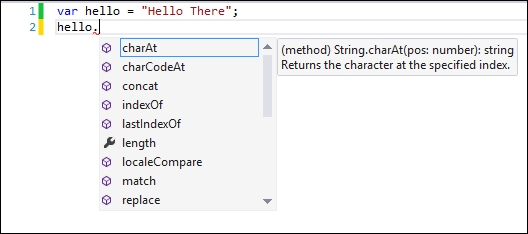One of the primary benefits of compiled languages is that they provide a more plain syntax for the developer to work with before the code is eventually converted to machine code. TypeScript is able to bring this advantage to JavaScript development by wrapping several different patterns into language constructs that allow us to write better code. We have talked a little bit about the static type system that TypeScript adds on top of JavaScript. Every explicit type annotation that is provided is simply syntactic sugar that will be removed during compilation, but not before their constraints are analyzed and any errors are caught. In this chapter, we will explore this type system in depth. We will also discuss the different language structures that TypeScript introduces. We will look at how these structures are emitted by the compiler into plain JavaScript. This chapter will contain a detailed look at each of these concepts:
- Types
- Functions
- Interfaces
- Classes
- Enums
- Modules
- Generic types
In Chapter 1, Getting Started with TypeScript, we wrote our first TypeScript application and briefly glanced at the static type system. Two variables were created and were given static type annotations to declare them as string objects. These type annotations put a specific set of constraints on the variables being created. These constraints allow the compiler and development tools to better assist in the proper use of the object. This includes a list of functions, variables, and properties available on the object. If a variable is created and no type is provided for it, TypeScript will attempt to infer the type from the context in which it is used. For instance, in the following code, we do not explicitly declare the variable hello as string; however, since it is created with an initial value, TypeScript is able to infer that it should always be treated as a string:
var hello = "Hello There";
The ability of TypeScript to do this contextual typing provides development tools with the ability to enhance the development experience in a variety of ways. The type information allows our IDE to warn us of potential errors in our code, or provide intelligent code completion and suggestion. As you can see from the following screenshot, Visual Studio is able to provide a list of methods and properties associated with string objects as well as their type information:

When an object's type is not given and cannot be inferred from its initialization then it will be treated as an Any type. The Any type is the base type for all other types in TypeScript. It can represent any JavaScript value and the minimum amount of type checking is performed on objects of type Any. Every other type that exists in TypeScript falls into one of three categories: primitive types, object types, or type parameters. TypeScript's primitive types closely mirror those of JavaScript.
The TypeScript primitive types are as follows:
- Number:
var myNum: number = 2; - Boolean:
var myBool: boolean = true; - String:
var myString: string = "Hello"; - Void:
function(): void { var x = 2; } - Null:
if (x != null) { alert(x); } - Undefined:
if (x != undefined) { alert(x); }
All of these types correspond directly to JavaScript's primitive types except for Void. The Void type is meant to represent the absence of a value. A function that returns no value has a return type of void. Object types are the most common types you will see in TypeScript and they are made up of references to classes, interfaces, and anonymous object types. Object types are made up of a complex set of members. These members fall into one of four categories: properties, call signatures, constructor signatures, or index signatures. Later in this chapter, we will start creating different object types using the different language entities in TypeScript.
Type parameters are used when referencing generic types or calling generic functions. Type parameters are used to keep code generic enough to be used on a multitude of objects while limiting those objects to a specific set of constraints. An early example of generics that we can cover is arrays. Arrays exist just like they do in JavaScript and they have an extra set of type constraints placed upon them. The array object itself has certain type constraints and methods that are created as being an object of the Array type, the second piece of information that comes from the array declaration is the type of the objects contained in the array. There are two ways to explicitly type an array; otherwise, the contextual typing system will attempt to infer the type information:
var array1: string[] = []; var array2: Array<string> = [];
Both of these examples are completely legal ways of declaring an array. They both generate the same JavaScript output and they both provide the same type information. The first example is a shorthand type literal using the [ and ] characters to create arrays. The resulting JavaScript for each of these arrays is shown as follows:
var array1 = []; var array2 = [];
Despite all of the type annotations and compile-time checking, TypeScript compiles to plain JavaScript and therefore adds absolutely no overhead to the run time speed of your applications. All of the type annotations are removed from the final code, providing us with both a much richer development experience and a clean finished product.
